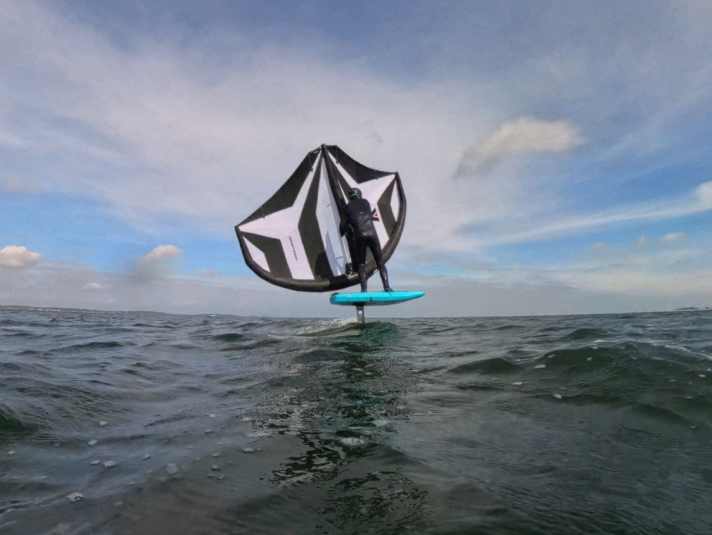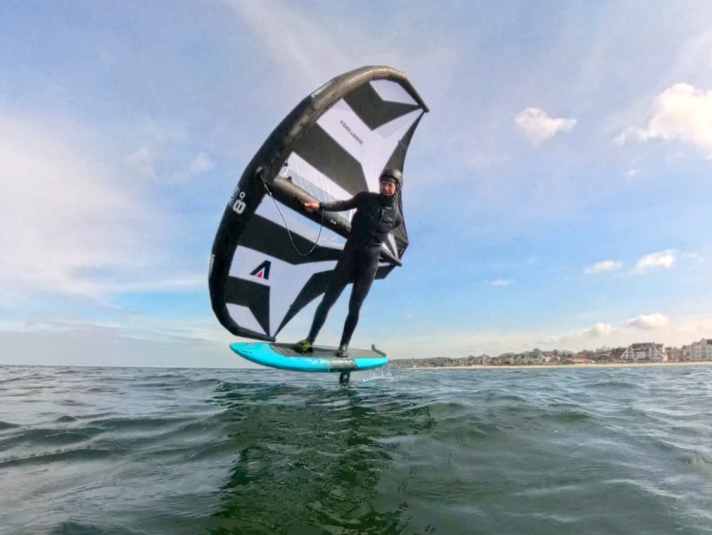Wings: Mega power for light winds - test of the Armstrong A-Wing XPS Lightwind
Manuel Vogel
· 31.03.2025






On land
With the A-Wing XPS Lightwind model, manufacturer Armstrong has a declared light wind performer in its portfolio, which is available in two sizes (7.0/8.0 square metres) - we tested the 8.0 square metre version. The leading edge appears relatively flat, but the wing has a particularly deep profile in the centre and rear areas. The Wing is ventilated via two standard valves; when inflating, it needs to be re-plugged once, but the air is quickly released again when deflating. With a wingspan of 374 centimetres, the A-Wing Lightwind is comparatively compact for a wing of this size, so the strut must of course be long. In contrast to light wind models such as the Duotone Ventis (Here is a test) the Armstrong A-Wing XPS Lightwind manages without additional struts. Instead, a small carbon rod and mini battens on the trailing edge provide the necessary tension. For the grip system, Armstrong relies on wrapped carbon grips, which are quite strongly flattened. The front handle is rather small in size but pleasantly stiff, although the positioning is not quite ideal in our opinion and could have been a little higher up. The rest of the equipment is beyond reproach: The seams on the leading edge and the wing tips have exemplary protection against abrasion and the materials used make a solid and cleanly finished impression. Despite this, the wing is remarkably light at 3.3 kilos on the scales - which raises hopes for use in the water!

On the water
The Armstrong light wind model provides a lot of lift when starting off, floats lightly over your head at a mere five knots and loads up immediately. You can feel the necessary pull, especially on the back hand, which signals: "Here we go!" When pumping, the soft profile turns out to be extremely efficient, pumping strokes are immediately converted into propulsion and with a base like the one we used Midlengthboard Duotone Skybrid 105you can start flying at well under ten knots. With these characteristics, the Armstrong A-Wing Lightwind impressively establishes itself in the ranks of the most powerful light wind wings.
After take-off, the wing stabilises nicely, is stable in the hands, but always has a slight tendency to pull upwind into the wind - which is particularly noticeable when you release your back hand from the wing. The stiff handles offer direct power transmission, but are not as comfortable as hoped for during longer sessions. Despite its size, the wing is surprisingly easy to control in manoeuvres, especially when tacking, it flips tip-to-tip almost effortlessly. In manoeuvres such as jibes, it wants to be guided a little more, and of course the long strut cannot be ignored. However, the impressive light wind performance pays a noticeable toll in stronger gusts above 13-14 knots: the centre of effort in the soft profile is then no longer quite as firmly cemented as desired.

Armstrong A-Wing XPS Lightwind - the conclusion
The Armstrong A-Wing XPS Lightwind does what it is supposed to do: It offers maximum power in marginal wind conditions! It also offers very pleasant handling in the light wind range of six to twelve knots. However, the wind range is limited at the top, so if you weigh less than 90 kilos, you can go for the 7.0 without hesitation.
Power, power, power!
Grip comfort; wind range
Position of the front handle
Armstrong A-Wing XPS Lightwind - technical data
- Test model: Armstrong A-Wing XPS Lightwind
- Wingspan: 374 cm
- Depth: n/a cm
- Weight (own measurement, without leash): 3.30 kg
- Weight: 412 g/m2
- Available sizes: 7.0/8.0 square metres
- Scope of delivery: Wing, bag, leash
- Price (test model): 1299 Euro
- Contact: To the website
- Special features: -
